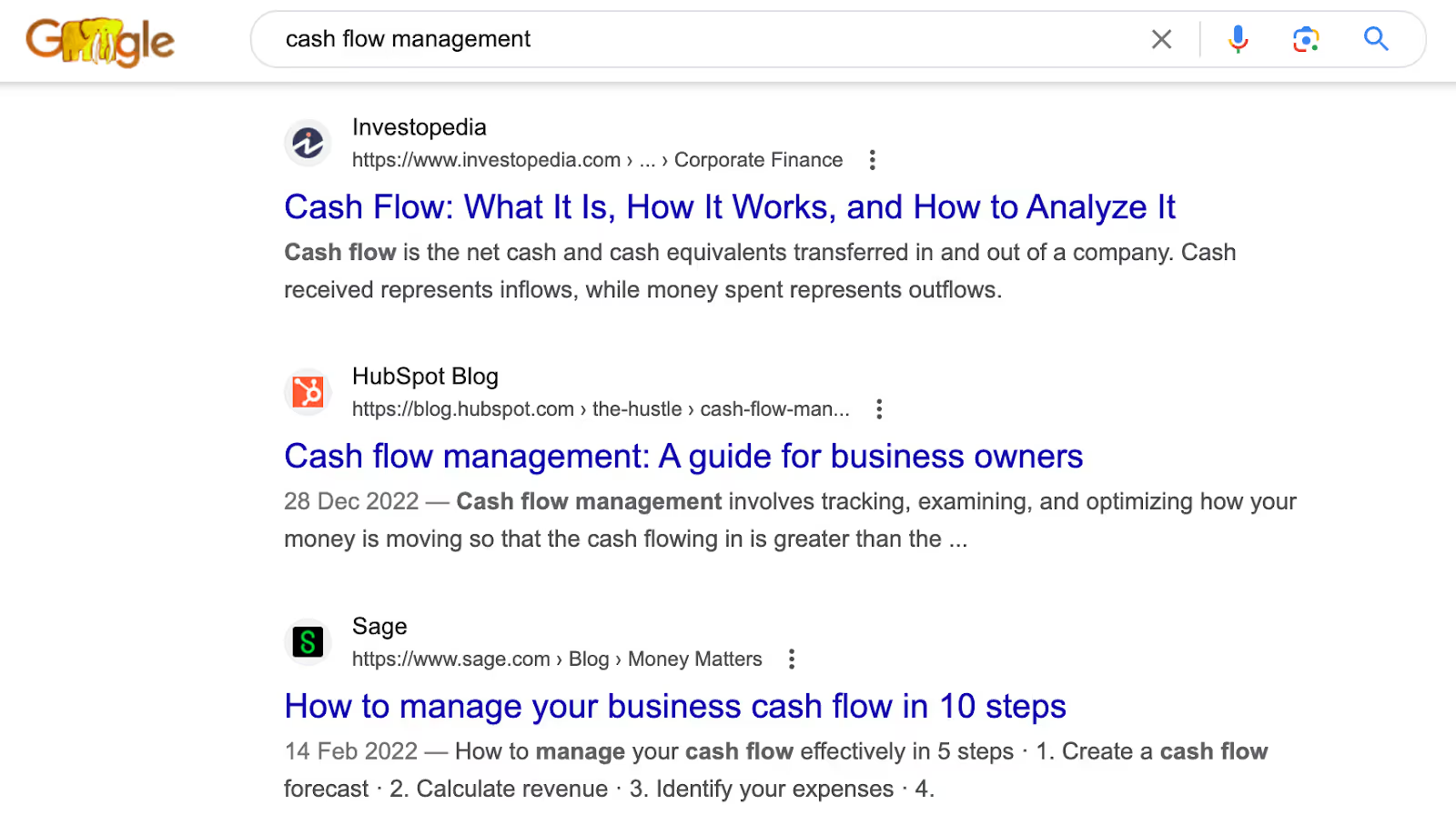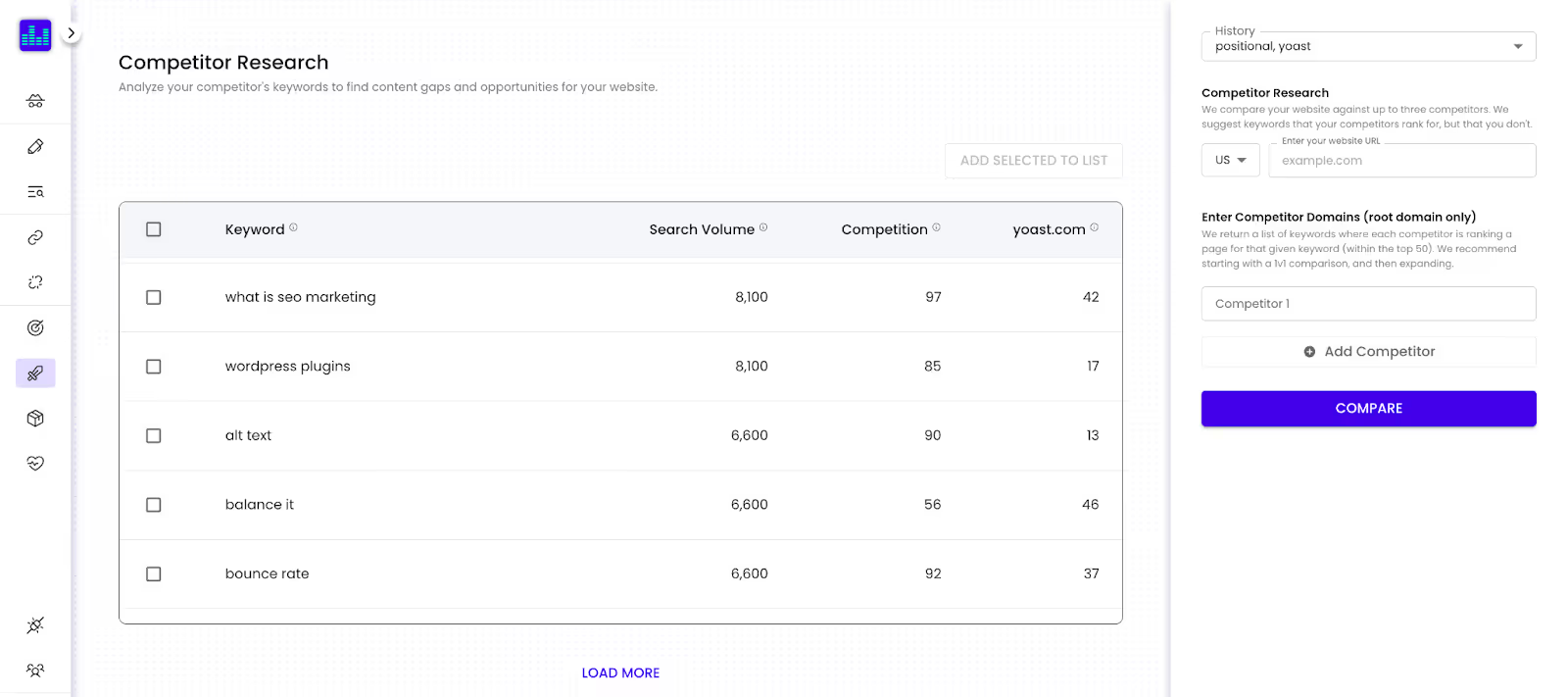Coming up with new content ideas takes time. It involves keyword research, competitor research, and content audits. But even if you diligently do all of this every quarter, you still might miss important topics.
Enter content gap analysis (also called keyword gap analysis). This process will uncover keyword opportunities that you, and in some cases your competitors as well, have missed. Targeting these missed keywords can help you rank higher in search engine results, drive more traffic, and take time-consuming guesswork out of creating content that your audience wants — and needs..
What Is a Content Gap Analysis?
A content gap analysis compares the keywords you’re ranking for in organic search against the keywords your competitors are ranking for to reveal missed opportunities.
Say, for example, your company makes an accounting tool, and you run a content gap analysis of your company and its three top competitors. You might discover that two of them rank well for the keyword “cash flow management” and you don’t. This suggests that there’s an opportunity to create content around cash flow management, or to update existing content to include relevant information about the topic.
Identifying keywords that you haven’t yet targeted or that you’re underperforming for will arm you with ideas for SEO content that will attract customers at all stages of the funnel. And when you start to expand the number of relevant topics your content covers, Google will see that you’re building topical authority and will consider you a rising expert in your industry.
4 Steps for Performing a Content Gap Analysis
A content gap analysis is a great way to identify content ideas you might have missed and is a critical part of any content strategy. Follow these steps to get started:
1. Find Competitive Websites
Start by identifying three to five of your top competitors. You might already have a couple in mind, but remember that you’re working with SERPs (search engine results pages) here, so ideally they’ll be competitors on Google. A direct competitor that has the same audience as you might not rank on Google at all — they might acquire customers via a different platform, so they won’t be as helpful in a content gap analysis.
To find competitors, you can plug your industry or core product into Google (for instance, you might search for “accounting tools” or “project management software”).
There will be two types of results:
- Direct competitors: Companies and products that are in direct competition with you.
- Search competitors: Companies that are targeting relevant keywords but aren’t in direct competition with you.

There are three different types of results here for the keyword “cash flow management.” If your core product is accounting software, Sage is your only direct competitor. Investopedia is an informational website, and HubSpot is a CRM platform. However, all three websites are targeting the same audience and the same keywords, which makes them all potential competitors to compare your website against.
2. Use a Tool to Identify Content Gaps
There are several tools you can use to speed up content gap analysis — just enter the URLs of your competitors, and you’ll get a list of keywords that both you and they are ranking for (or not ranking for).
Positional’s Competitor Research tool compares your keywords and search engine rankings against your chosen competitors to reveal content gaps and opportunities.

You can also use Semrush’s Keyword Gap tool and Ahrefs’ Content Gap report to compare your keyword rankings with your competitors’. Both tools let you enter multiple domains at once to get a birds-eye view of how you’re performing.
If you’re looking to test the waters on a small budget, try Google Search Console (GSC). You can get click-through rates (CTRs) and ranking data for your content. If GSC shows you that you’re ranking moderately well but not incredibly well for certain long-tail keywords, there could be an opportunity to optimize existing pieces of content or create new standalone pieces for those long-tail keywords.
Once you’ve run your keyword gap analysis, download the report so you have access to the keywords, search volumes, and potential gaps.
3. Make a List of Keywords
You’ll now have a list of keywords that competitor content ranks for, but your content doesn’t. The raw data you’ve collected should also include the monthly search volume, keyword difficulty, and current ranking position of your competitors for each keyword. This becomes a working document you can edit and add to.
When going through the list, you’ll notice two entry types:
- Keyword gaps in your existing content: You may have content that’s targeting a certain keyword but that isn’t performing well (in other words, it’s not appearing on the first page or two of search results). You can optimize this content and add new related keywords to give it a boost on SERPs.
- Missing keywords. These are keywords that you’re not targeting or ranking for at all. You’ll need to create fresh content to compete for placement on SERPs.
Most tools will show whether you’re ranking for a keyword. If you rank poorly, you can optimize your existing content to improve performance. If you’re not ranking at all, add the keyword to your list of new content ideas or your editorial calendar.
4. Consider the Customer Journey
Keyword research tools are great for uncovering keywords quickly, but it often makes sense to go beyond standard tools and think critically about the buyer’s journey as a source of new content ideas or topics.
This will help you identify specific pain points and potential friction points throughout the buying process — and come up with questions and topics you might have missed.
Here are some ways to do this:
- Speak to sales or support staff: Ask customer-facing departments to share common questions, objections, and hesitations they’ve heard from prospects.
- Examine customer reviews: Read your own or your competitors’ reviews to identify common themes and uncover questions that prospects might have about your product or service.
- Look at Google’s People Also Asked section: Search for keywords relating to your product, industry, or service and click into the People Also Asked section in the search results to find ideas you might have missed.

This review of Mailchimp presents some potential keyword ideas that come straight from an existing customer:
- “automate email campaigns”
- “customizable signup forms”
- “grow subscriber list”
- “opt-in processes”
- “open rates”
You can then plug any of these new keywords into Google to generate a list of questions (and more potential content gaps) in the People Also Asked section.

Tips for Choosing the Right Keywords
If your competitors have a lot of content, you might find yourself with a very long list of potential keywords. Here are some ways to hone in on the right keywords.
Consider a Keyword’s Relevance
Some of the keywords in your content analysis report won’t be relevant to your audience, product, or service.
For example, if your accounting tool is for creative freelancers, you won’t want to spend time creating content around keywords like “accounting for construction” or “manufacturing accountancy,” even if your competitors are ranking for those terms.
Choose Lower-Difficulty Keywords to Start
Keyword research tools will also reveal a keyword’s difficulty score. The higher the difficulty score, the harder it will be for new content to rank well.
When you’re starting out, look for keywords with difficulty scores below 65. These terms are easier to rank well for. Once you’ve tackled the lower-difficulty keywords, you can move on to those with a higher score — just be mindful that it will take you longer to see results.
Create Groups or Clusters of Keywords
When working through your lists, cluster keywords that touch on similar topics and share the same search intent. For example, you might group “cash flow management,” “improve cash flow,” “daily cash flow,” and “cash flow inventory” and include them all in one piece instead of creating a new piece of content for each keyword.

Positional’s Keyword Clustering tool helps you group a current list of keywords based on SERP data.
Keep in mind that you should check the search intent of your keywords before you cluster them. All keywords in a group should match the same search intent. “Improve cash flow” and “cash flow management tool” might look similar, but it’s likely that someone searching for a tool is ready to invest in a product (transactional search intent), while someone looking to improve their cash flow might be looking for tips (informational search intent).
Refreshing Existing Content to Fill Gaps
At this point, you’ll have two lists of content ideas: new content that targets keywords you’re not yet ranking for and existing content that needs updating.
When refreshing existing content, you’ll need to do more than drop in new keywords to improve its ranking. We’ve written a complete guide to refreshing content, but here are some quick steps to follow:
- Look for outdated information: Update any date or time references and check that companies and examples are still relevant.
- Check the search intent: Make sure you’re still matching the search intent if you update an existing piece.
- Use an optimization tool: Upload your piece into a content optimization tool to see if you're mentioning all relevant words, phrases, and topics (not just keywords). This will improve your on-page SEO.
- Update your meta information: Make sure your meta description and title tags still match the purpose and topic of the piece, and update them to include any new keywords if necessary.
- Add missing sections: Use your content analysis to find subtopics you’ve missed and add these as sections to old content.
Final Thoughts
An effective content gap analysis can help you discover keywords you’ve missed or haven’t considered so you can create quality content that meets the needs of your target audience, expand your content library, and improve your search rankings. Filling content gaps will help you show Google that you’re a topical authority, and it’ll provide more opportunities for you to compete with similar brands in your industry.





